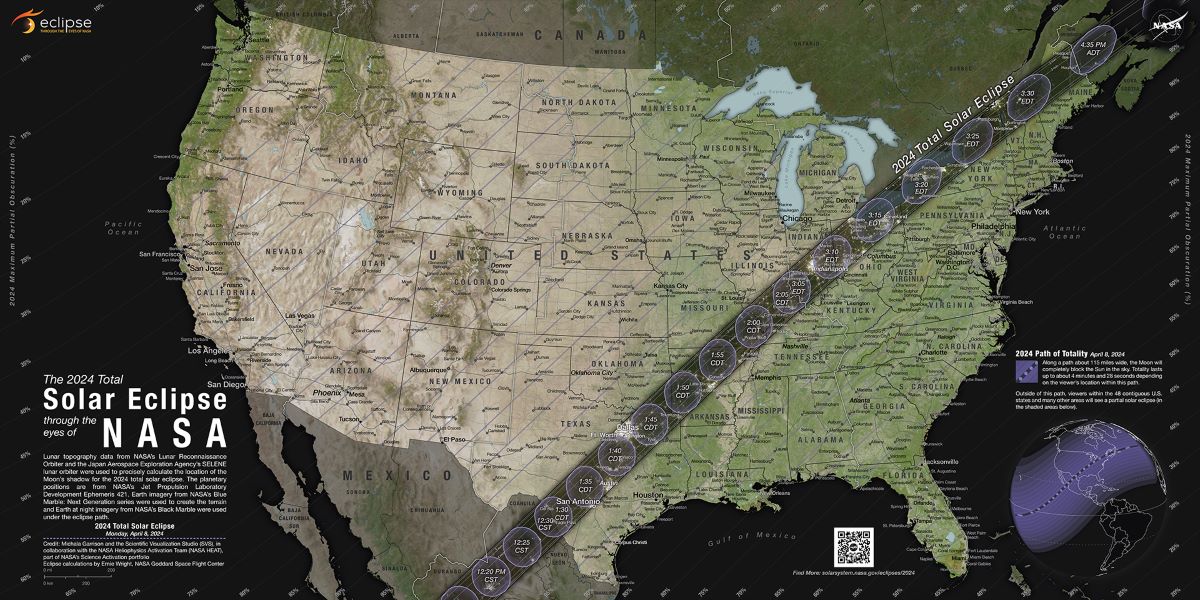A total solar eclipse — when the sun, new moon and Earth align — happens about once every 18 months somewhere in the world. A solar eclipse can be total, partial, annular or a hybrid, with some form occurring two to five times a year. The event itself isn’t extremely rare, but it’s less common for the shadow, or umbra, of a total eclipse to cross a swath of populated areas — and even less common that they cross the US.
So when they do happen, they’re highly-anticipated events where people get to experience what is called “eclipse totality.”
The umbra of the total solar eclipse will cross the US from central-south Texas to the top of Maine, with a partial eclipse visible on the east coast and to the west of what eclipse watchers call the “line of totality.”
But even if you’re outside of this zone, in an area with a partial eclipse, you’ll be able to watch it — if you take the proper precautions.
The science of solar eclipses
Total solar eclipses, which can last anywhere from a few seconds to a few minutes, allow scientists to observe the sun in a way that is impossible at any other time.
“Solar physicists who study the sun during eclipses are looking at layers called the ‘chromosphere’ and the ‘corona,’” said Sally Dodson-Robinson, an associate professor of physics and astronomy at the University of Delaware.
These layers are higher in the sun’s atmosphere and don’t produce a lot of light, so they aren’t visible unless the part of the sun we normally see — the “disc” of the sun — is blocked. The “ring of fire” seen during a total solar eclipse are those usually invisible chromosphere and corona layers.

Astronomer Sally Dodson-Robinson (Courtesy)
It’s breathtaking for anyone to witness. The phenomenon also offers solar physicists an opportunity to better understand the sun, solar flares and the magnetic energy those layers release.
“The kind of light that comes out of those layers is not the same as the kind of light that comes out of the regular disk of the sun that you would see with your eyes,” Dodson-Robinson said. “What actually happens is that because those layers of the sun are so hot, but also so tenuous, they don’t emit a full rainbow of starlight. Instead, they emit light in very specific colors.”
Scientists use special filters tuned to those colors of light to measure the intensity and calculate the temperatures of the corona and chromosphere. Why does that data matter? Basically, because there is still a lot that scientists don’t understand about the sun.
“We know generally that you have magnetic fields that are anchored on the surface of the sun that extend up very high,” Dodson-Robinson said. “We also know that those can break and reconnect. But the exact mechanism behind converting that released energy into heat is not perfectly well understood.”
Understanding things like that helps scientists understand the sun’s activity cycles, including solar winds that blow particles out into the solar system, sunspots and its magnetic energy.
While technology in general has evolved quite a bit since the last total eclipse crossed the US, the technology of studying eclipses has not changed much over the last seven years.
“Our technology has not changed since 2017, except for using newer cameras and filters,” said Shadia Habbal, a professor of solar physics at the University of Hawaiʻi’s Institute for Astronomy whose research focuses on solar wind and eclipses.
Staying safe while viewing an eclipse
Even if you’re not within the path of totality, you need to practice optical safety to prevent damaging your eyes.
Dodson-Robinson warns that the popular cardboard glasses people often use to view eclipses can be unsafe if they get even a tiny hole in them or if they don’t fit properly.
If buying expensive non-cardboard, solar-safe glasses is out of budget, NASA recommends solar-safe viewers with filters that are ISO 12312-2. NASA does not endorse any brand of solar-safe viewers but does offer, along with partner organizations, a randomized list of manufacturers it has confirmed as producers of appropriately filtered viewers. NASA additionally does not suggest that people purchase solar-safe viewers on sites like Amazon or eBay, but directly from those manufacturers. Be sure to inspect any viewers for holes before using them.
Other viewing options include pinhole and optical projection, where you can safely view the eclipse indirectly.
If you’re viewing from a partial eclipse area, where the totality will not be visible, there will be no time during the partial eclipse when it’s safe to look directly at the sun without a solar-safe viewer.
What about smartphone photos?
Some smartphone cameras have incredible zoom lenses that might seem perfect for capturing the eclipse, but be careful. Digital Camera World published a guide to capturing last October’s partial eclipse event by eclipse enthusiast Jamie Carter, who warned that pointing your smartphone lens at the sun during an eclipse can quickly damage its sensor.
Photographing the eclipse with your phone is possible, he wrote, but it takes planning. You can cut up an extra ISO 12312-2 viewer and use the solar-safe filter to cover your phone’s lenses; this will protect it, but the photo quality won’t be high. The best amateur smartphone photos of an eclipse are photographed through the eyepiece of a telescope fitted with a neutral density filter.
Where to watch the eclipse
The best place to watch the April 8 eclipse is on the path of totality, which includes Cleveland, Ohio; Erie, Pennsylvania; and Buffalo, New York.
While it’s a good idea to go where the sky isn’t obscured by tall buildings, there is no need to go someplace remote to get a better view. The quality of the view will be based on how close you are to totality and cloud cover.
“Basically everywhere along the I-95 corridor has a really bright sky, so it’s not that great for amateur astronomy,” said Dodson-Robinson. “But for looking at the sun, basically anywhere that you can see the sun is fine. That’s all you need.”
Before you go...
Please consider supporting Technical.ly to keep our independent journalism strong. Unlike most business-focused media outlets, we don’t have a paywall. Instead, we count on your personal and organizational support.
3 ways to support our work:- Contribute to the Journalism Fund. Charitable giving ensures our information remains free and accessible for residents to discover workforce programs and entrepreneurship pathways. This includes philanthropic grants and individual tax-deductible donations from readers like you.
- Use our Preferred Partners. Our directory of vetted providers offers high-quality recommendations for services our readers need, and each referral supports our journalism.
- Use our services. If you need entrepreneurs and tech leaders to buy your services, are seeking technologists to hire or want more professionals to know about your ecosystem, Technical.ly has the biggest and most engaged audience in the mid-Atlantic. We help companies tell their stories and answer big questions to meet and serve our community.
Join our growing Slack community
Join 5,000 tech professionals and entrepreneurs in our community Slack today!

The person charged in the UnitedHealthcare CEO shooting had a ton of tech connections

From rejection to innovation: How I built a tool to beat AI hiring algorithms at their own game

Where are the country’s most vibrant tech and startup communities?




